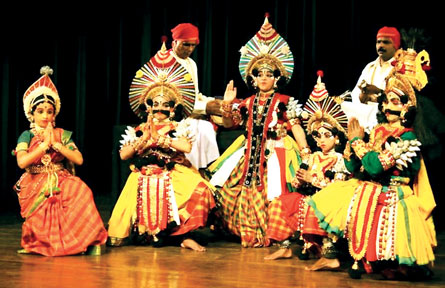|
Yakshagana:
India's least popular devotional dance
by Subashini Pathmanathan
One of the classical dance forms based on Karnataka is called
Yakshagana, an admixture of folk and classical dance forms of India. In
Karnataka the dance form was called by different names. The northern
part of Karnataka called it Doddaata. In Mysore it was known as
Moodalapaya. But later it was refined and called Yakshagana.
Another folk dance was called Yakshagana Bombeyaata.
(It was a puppet show). Yakshagana can be considered as a classical
dance form of Karnataka.
It is almost a drama based dance form almost similar to the
Bhagavatha Mela dance drama of Tamil Nadu.

Like almost all the Indian classical dance forms Yakshagana is deeply
rooted in the Hindu religious puranas and epics, but it was mostly
cherished by the Vaishnava cult. It is based on four important elements
such as dance, drama, music and dialogue. Most of the themes reveal the
dharma doctrine by showing the struggle between good and evil. At the
end the triumph of good over evil is depicted.
Music
The music is provided by professional musicians known as Bhagavathars
who use two main instruments. One is a maddale and the another is chande.
But chande is not always used, except for certain scenes. The maddale is
a drum. The dance drama is based on certain stories generally called
prasangas which were written during the 17th century and thereafter.
The ragas selected for the dances must suit and reflect the different
emotional moods of the scenes. For instance, certain ragas such as Thodi,
Mohanam and Savari ragas are used to portray sorrow. The style of
singing is entirely different in Yakshagana. The language of the music
is in Kannada.
The instrument chande is used only for certain scenes such as
violence, war and terror. Among all the scenes, the most enjoyable are
from Mahabaratha and Ramayana. Different emotions are exhibited through
a variety of footwork and gathi petha (different tempos). The important
characters are introduced to the audience which is called Voddolagas.
The characters dance and enter the stage with a variety of hand gestures
(Muthras) and footwork (steps) with different beats. Introducing the
male characters to the audience is generally common in most of the folk
based ritual dances. The stage where the performances take place is
called Rangasala which is installed in the temple grounds. And it is a
temporary shed built with bamboo poles and decorated with fresh mango
leaves.
Night
Like ancient folk dances classical dances and dramas of olden days
Yakshagana was staged throughout the nights. Like all others Indian
classical dances and folk dances, Yakshagana is also based on the Natya
Sastra. Therefore, it has a lot of similarities, resemblance, links and
relationships, with other Indian dance forms. Especially, it resembles
the stances, jumps, vigorous movements, make-ups, dressing and subtle
graceful facial expressions of Kerala's State dance Kathakali and the
folk dance of Tamil Nadu known as Therukoothu. Like Kuchupidi and
Bhagavathamela in between the dances the dialogue takes place. As in
many ancient Indian classical dance forms, the female characters are
played by the males alone.A variety of hand gestures (muthras) which are
common in Bharatha Natyam, Kuchupidi and Kathakali are used in
Yakshagana. For instance, Pathaakam, Mirugashirusam, Kadakamugam, Musti
are some of the mudras used in this dance form. Thandava and Lassiya the
two different important concepts are equally used in the dance drama. It
provides enough and equal opportunities to use the Angika Abinaya,
Akariya Ahbinaya, Vachika Abinaya and Saathvika Abhinaya. Each character
has a distinct type of make-up. When the characters do their allocated
roles through Angas (limbs or organs) it is considered as Angika Abinaya.
Different types of dresses, head gears, colourful turbans, beautiful
crowns, kiridam, and chest kavasams, shoulder kavasams, and rich
glittering grand dresses, a variety of ornaments, are specially worn by
the participants in the form of Akaraiya Abinaya (dressing) of
Yakshagana. Often the decorations and dresses resemble the Kathakali
dancers.
The interpretation of the songs through dialogue in between the
songs, or when they dance for the Bagavathars' songs, by interpreting
through Abhinaya could be considered Vachika Abhinaya. When the
characters perform their roles with full emotional involvement, it can
be regarded as Sathvika Abhinayam.
Yakshagana ends with mangalam as other classical dance forms. The
dance drama ends before sunrise. As other classical dance forms,
Yakshagana is also subjected to innovations. Yet, many traditional
professional artistes, gurus and art lovers, want to maintain the
pristine purity of the art. |


